Grilled chicken breast, barbecue chicken, curry chicken, chicken parmigiana— I could go on and on about all the yummy chicken options available to us (if we choose chicken as a protein source). But you may wonder about how farmers raise chickens—how they are bred, given veterinarian care and safely contribute to our food supply.
No Foul in Fowl Farming
Good farming and good food start with providing safety, sustainability, sanitation and sanctuary for farm animals. Farmers that raise chickens put multiple actions into play to ensure they provide these foundational aspects: proper nutrition (clean water and feed); protection from predators and disease; adequate room to grow and move; and veterinary care to all farm animals, including chickens.
Similar to raising cows, turkeys and pigs, farmers uphold animal welfare guidance to ensure ethical standards and low-to-no instances of mistreatment of chickens. For chickens specifically, farmers abide by the National Chicken Council Animal Welfare Guidelines. In addition, there are refined regulations and laws (like the Animal Welfare Act and the Poultry Product Inspection Act) established by the United States Department of Agriculture (USDA) to ensure proper handling and processing of animals meant for food production and further regulations under the Food Security Act to protect consumers who purchase farm products.
What’s in Old MacDonald’s Barn?
Not all chicken farms are the same. Some chickens are raised to lay eggs (layers), and other chickens are raised to be used for their meat (broilers). Some farms raise both layers and broilers. But the breakdown goes even further: poultry production begins with primary breeders, the genetic stock for the industry. Over the years, farmers have continued to select birds that have naturally grown better, laid better eggs, produced better meat and used them to produce future generations of chickens. Among these primary breeders are eggs from multiplier flocks that hatch to become production birds (broilers and table-egg layers) for human consumption.
The incorporation of “genetic selection” techniques into raising chickens contributes to why commercially grown chickens are bigger than they used to be almost 100 years ago. It is true that chickens were smaller when commercial poultry farming began in the 1920s. By selectively breeding birds with desired characteristics and by more efficiently feeding them, they now grow at better rates. In fact, the genetic selection of chickens contributes to more sustainable farming—the better a chicken grows without being fed more feed, the fewer inputs (water, energy, crop maintenance) are needed to grow and harvest the feed.
The Chicken Dish
Most of us know that chicken provides a great source of protein and other nutrients. And, likely the same number of us have heard some “squawking” about the safety of chicken consumption. Terms like “antibiotics,” “hormones,” “chlorination” and “vaccination” all come to mind. Allow us to give some food safety “nuggets of information” on these terms:
- Antibiotics – Under the regulations of the U.S. Food and Drug Administration (FDA), chickens (and all farm animals) are treated with antibiotics if they become sick and their administration occurs via the guidance of a veterinarian. Medically important antibiotics are not allowed for growth promotion. Additionally, once an animal is treated with antibiotics, it is withheld from the food supply chain until its treatment is complete and the medication is no longer in its system. USDA’s Food Safety and Inspection Service (FSIS) conducts a monitoring program to ensure that antibiotics are efficiently eliminated from animals’ systems and that no unsafe residues are detected in poultry and meat.
- Hormones (and steroids)- Let’s first be clear, no meat, no matter if it’s organic, grass-fed or free-range, is 100 percent free of hormones. Hormones are naturally produced by all animals (and by people too). Any naturally occurring hormones that may be present in poultry at very low levels are not harmful to consumers. In fact, in the 1950s, FDA regulations established that chickens are not to be given hormones or steroids for any purpose (including growth) AND any chicken product labeled “hormone-free” should be labeled “raised without any added hormones…just like all poultry products.”
- Chlorinated Chicken– It is true that diluted chlorinated water is used to rinse chicken in its processing for disinfection purposes in some U.S. processing plants. However, the chlorine is at very low levels which research has found to be safe. USDA’s Food Safety and Inspection Service (FSIS) established regulations for using highly diluted chlorine for only antimicrobial purposes. Following treatment, processing steps ensure that ZERO chlorine is in/on the chicken before it reaches consumers. Although the European Food Safety Authority (EFSA), USDA, FDA and Codex Alimentarius Commission have established that this technique is safe, many U.S. plants are using alternative methods for ridding the chicken of bacteria.
- Vaccination– On many farms chickens are vaccinated to protect them from illness and infection. As directed by the USDA, the vaccines are administered by a veterinarian. Once the vaccination is done, chickens are withdrawn from the supply chain, meaning the vaccine is not at risk of reaching the consumer. Over 80 percent of chicken farms vaccinate against many infections including Newcastle disease, Salmonella, avian encephalomyelitis, chicken anemia virus, reovirus and fowl pox. Many farms also vaccinate for E. coli and cholera.
Hopefully, these chicken tips enlighten you a bit on how chicken farms work and give you some useful food safety information on poultry production. Just think of this as a little something to “chew on” the next time you want a little cluck for your buck.

